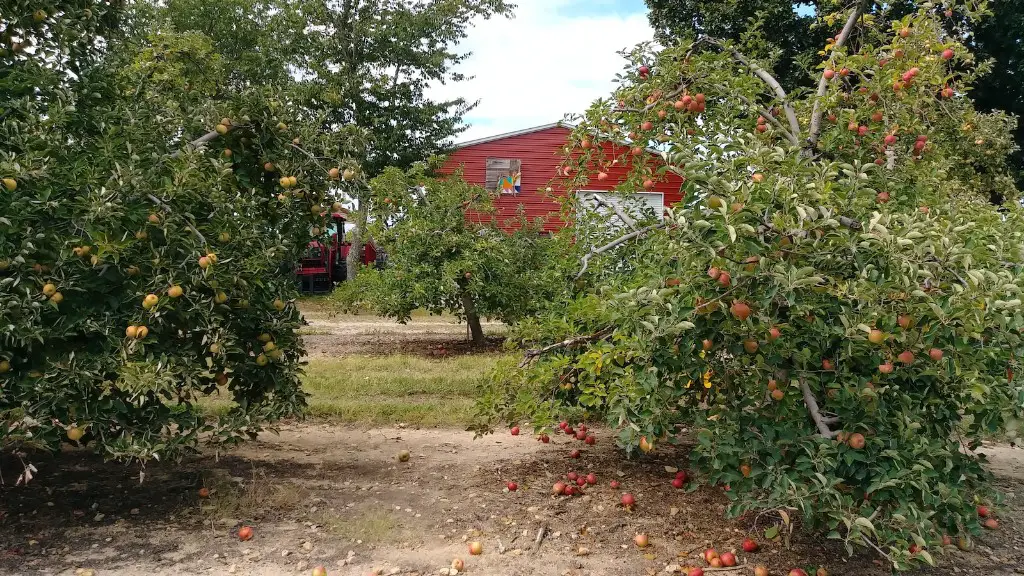It is commonly believed that cherry trees grown in parks and residential areas are too short to pick from, but this is far from the truth. A cherry tree can reach substantial heights, ranging from 15-25 feet tall and living for 50-80 years. The life span and height of the tree will depend on its variety, location, and environment.
The height of a cherry tree is one of the most important aspects when it comes to fruit production. A shorter tree with a smaller canopy of leaves will produce fewer and smaller cherries, while a taller tree with a wide canopy of leaves will produce more cherries of a bigger size. Additionally, the extra height will provide larger branches and branch tips to support the heavier cherries.
Horticultural experts agree that soil and water play the most significant role when it comes to cherry tree height. Without proper irrigation and well-drained soil, the roots of the cherry tree will have difficulty penetrating deep into the ground. This will cause the tree to remain shallow-rooted and run the risk of toppling over due to a lack of support.
When growing cherry trees for sale or consumption, it is important to give the tree ample space to grow in. Crowded locations will limit the growth of the tree and cause it to become congested and unhealthy. Additionally, it is important to prune cherry trees at the proper time of the year, as it will open space for new foliage to form and photosynthesis can take place to further assist with growth.
Fertilization is a key part of maintaining a healthy cherry tree. Adding additional nutrients to the soil will give the tree necessary components to reach its full height potential. Trees should also be regularly inspected for pests, disease, and other health issues that can affect growth.
By following the right steps, a cherry tree can reach its full potential and become a large, beautiful tree. Its height can be used to add privacy to an area or provide shade for an outdoor gathering. They will also provide an abundance of cherries, a delicious treat and refreshing snack!
Climate Requirements
The climate in which the cherry tree is grown is critical to its growth. Different varieties of cherry trees will require a different environment to thrive and reach full potential height. Some guidelines to consider when planting a cherry tree are the minimum and maximum temperature range and the amount of frost-free days the tree needs.
Cherry trees grow best in temperate climates because of the warm days and cool nights. The cold winter season allows these trees to rest and prepare for the upcoming growing season. Most cherry trees need at least 25-30 frost-free days to properly grow. For example, the sweet cherry tree is estimated to require 750 to 900 chilling hours in order to flower and fruit.
It is important to choose a variety of cherry tree that is suitable for the local climate, as some do not require as many chill hours as others. Knowing how much sunlight the tree needs is also essential for optimal growth and for avoiding disease. In general, cherry trees require about 6-8 hours of full sunlight per day.
Location Matters
Where the cherry tree is planted can significantly affect its growth and health. For example, planting a cherry tree near a heat source, such as a building or south-facing wall, can reduce the amount of exposure to sunlight and create a microclimate around the tree. In addition, planting a cherry tree in starves soil with poor drainage can inhibit the root’s ability to absorb nutrients.
It is also important to pay attention to prevailing winds. Placing the tree in an area that has strong winds can cause the tree to become stressed, while also making it susceptible to diseases and pests. A windbreak can be placed near the tree to help alleviate some of the stresses of being exposed to too much wind.
Locating the cherry tree in an area with good soil structure and well-draining soil is essential for its growth. A good soil structure will hold the necessary nutrients for optimal growth, as well as allowing air and water to move easily in and out of the rootzone.
Pruning and Training
Correct pruning and training is an important part of cherry tree care as it not only controls the height and shape of the tree, but also helps to improve airflow and light penetration. By pruning and training the cherry tree it can achieve a beautiful form and balance that will allow for easier harvesting, as well as provide ample space for new branches to form.
It is important to prune the cherry tree in order to remove any dead or dying branches, encourage new growth, and increase air circulation. Pruning can also help limit the size of the tree, so that it reaches a desired height. Another advantage of pruning is that it will reduce the amount of time the tree spends in a vegetative state and help it focus on producing fruits instead.
Training the cherry tree should begin after the tree has become established. This can include staking the tree, tying branches together, and encouraging the tree to grow in a certain direction. By training the tree to grow in a desired direction, it will remain at a preferred height and will produce beautiful, bountiful cherries for many years.
Harvesting Cherries
One of the most exciting moments for many homeowners is when their cherry trees begin to bear fruit. After years of waiting, it is finally time to start harvesting! The peak season for sweet cherries is from late spring to early summer, while sour cherries are harvested from mid to late summer.
When it comes to picking the cherries, it is best to place the tree’s ladder near the trunk and use a pole with a detachable basket or clip to harvest the fruit. Additionally, it is important to be aware of the timing. The branches with ripe, juicy cherries have a tendency to bend as they become heavier, so it is best to harvest them while they are still higher up in the tree.
Cherries should be harvested when they are ripe and ready, as they will have the most flavor and sweetness. To test if the cherries are ready, try picking one and tasting it. If it is sweet and juicy, then the rest of the cherries should be ready to harvest.
Protecting from Pests and Diseases
Due to their sweet taste and soft flesh, cherry trees are also prone to several pests and diseases. Some of the most common include brown rot, leaf spots, crown gall, and various insects, such as aphids and cherry shoot borers. By being proactive and taking the right steps, it is possible to protect the tree from any of these issues.
The first step is proper maintenance. Regularly pruning and monitoring the tree for any signs of disease or pest infestation is key to keeping the tree healthy and disease-free. Additionally, it is important to keep the ground around the tree free of weeds and debris, as this can act as a food source for pests.
Spraying trees with the proper insecticides and fungicides is also essential for keeping pests and diseases away. Spraying should be done on a regular basis, and only with products that are labeled for the specific purpose of combating a particular pest or disease. It is also important to apply the products according to the instructions, as using too much can damage the tree.
Conclusion
When grown properly, a cherry tree can reach substantial heights of 15-25 feet tall and last for 50-80 years. Its height is one of the most important aspects when it comes to fruit production, so it is important to ensure it is receiving the proper water and soil, ample sunlight, and the right climate. It is also important to correctly prune and train the tree, and regularly inspect it for pests and diseases in order to protect it.




